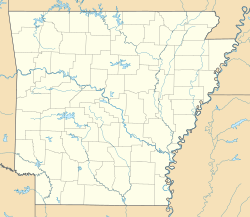Hickory Creek (Buffalo Creek tributary) facts for kids
Quick facts for kids Hickory Creek |
|
|---|---|
|
Location in Arkansas
|
|
| Country | United States |
| State | Arkansas |
| County | Polk County |
| Physical characteristics | |
| Main source | Polk County, Arkansas, United States 34°21′20″N 94°22′37″W / 34.35556°N 94.37694°W |
| River mouth | Polk County, Arkansas, United States 869 ft (265 m) 34°23′50″N 94°27′32″W / 34.39722°N 94.45889°W |
| Basin features | |
| Tributaries |
|
Hickory Creek is a small waterway located in Polk County, Arkansas, in the United States. It's known as a tributary, which means it's a smaller stream or river that flows into a larger one. For Hickory Creek, its waters eventually join the Buffalo Creek.
Contents
What is a Tributary?
A tributary is like a branch of a tree, but for rivers! It's a smaller stream that flows into a larger river or lake. Tributaries are super important because they collect water from a wide area and bring it to the main river. This helps keep the larger river full and flowing.
Hickory Creek's Journey
Hickory Creek starts its journey in Polk County, Arkansas. It then travels a short distance before its waters mix with those of Buffalo Creek. This connection is a key part of the local water system in this part of Arkansas.
Where is Hickory Creek Located?
Hickory Creek is found in the beautiful state of Arkansas, often called "The Natural State." Specifically, it's in Polk County, which is in the western part of Arkansas. This area is known for its rolling hills, forests, and many small streams and rivers.
Polk County's Natural Beauty
Polk County is a place where nature thrives. It's home to parts of the Ouachita National Forest, which means there are lots of trees, wildlife, and natural landscapes. Creeks like Hickory Creek are a common sight here, adding to the county's green and watery scenery.
Life Around the Creek
Creeks and rivers are bustling hubs of activity for plants and animals. Even a small creek like Hickory Creek supports a variety of life. The water provides a home for fish and insects, while the banks offer shelter and food for many land animals.
Plants and Trees
Along the banks of Hickory Creek, you would likely find many types of trees and plants. Common trees in Arkansas include oak, hickory (which might be how the creek got its name!), and pine trees. These trees provide shade, help prevent soil from washing away, and offer homes for birds and other creatures. You might also see smaller plants like ferns and wildflowers growing close to the water.
Animals and Wildlife
Many animals depend on creeks for survival. In and around Hickory Creek, you could spot various creatures.
- Fish: Small fish like minnows and sunfish often live in creeks.
- Insects: Dragonflies, damselflies, and various water bugs are common. Their larvae often live in the water.
- Amphibians: Frogs and salamanders love the damp environment near creeks.
- Reptiles: Turtles and non-venomous snakes might be seen basking in the sun or swimming.
- Mammals: Animals like raccoons, deer, and squirrels often visit creeks to drink water or find food. Birds also frequent the area, looking for insects or fish.
Why Creeks Are Important
Creeks like Hickory Creek play a vital role in our environment. They are much more than just flowing water!
Part of the Water Cycle
Creeks are an important part of the water cycle. They collect rainwater and snowmelt, carrying it downstream to larger rivers and eventually to the ocean. This process helps to move water around the planet, making sure that different areas get the water they need.
Supporting Ecosystems
Every creek is a mini-ecosystem. It's a place where living things (plants, animals, fungi, bacteria) interact with non-living things (water, rocks, sunlight, air). Creeks provide water, food, and shelter, creating a perfect habitat for many species. Protecting creeks means protecting the amazing variety of life that calls them home.
Exploring and Learning
Small creeks offer great opportunities for learning about nature. If you ever visit an area with a creek like Hickory Creek, remember to be respectful of the environment.
Nature Observation
You can learn a lot by simply observing. Look for animal tracks in the mud, watch insects buzzing around the water, or try to spot different types of birds in the trees. You might even see small fish swimming in clear spots.
Environmental Care
It's important to keep creeks clean. Litter and pollution can harm the plants and animals that live there. Always remember to take out anything you bring in and avoid disturbing the natural habitat.
Fun Facts About Hickory Creek
- Hickory Creek has an official identification number from the United States Geological Survey (USGS) called a GNIS I.D. (Geographic Names Information System Identifier). For Hickory Creek, this number is 50049. It's like a unique ID card for the creek!
- Hickory Creek has two smaller tributaries of its own: Indian Creek and Little Hickory Creek. This shows how water systems are connected, with smaller streams feeding into larger ones, which then feed into even larger ones.



